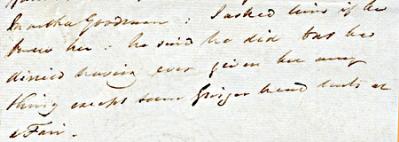Harrold Odell Paths to Crime Walk stop 10 Odell Fair
Odell Fair
Travelling Salesmen
At about 7pm on Wednesday 14 May 1845 a man went into the baker's and grocer's shop of William Wykes in Sharnbrook and gave Wykes' wife Anne a shilling to pay for half an ounce of tobacco. She spotted that the coin was counterfeit and refused it, and the customer, William Holland, paid with three halfpennies. Holland then went on to Odell where he took lodgings at the Bell Inn. Odell Fair was in progress and the next day Holland set up a stall selling gingerbread. About three o'clock in the afternoon he went into the Bell Inn and had half a pint of ale, for which he also tendered a fake shilling. When the innkeeper's wife returned it Holland said he thought the coin had been darkened by being in his pocket with some gunpowder, and gave the innkeeper's wife another shilling. That evening Holland again tried to buy tobacco with the fake shilling, this time from grocer Mary Hine. Holland stayed at the Bell until the following Monday. Yet again it was spotted and he repeated the gunpowder excuse.
Holland stayed at the Bell until the following Monday, when he moved on to Harrold. Here he successfully bought another half ounce of tobacco from Sarah Salisbury who took the counterfeit shilling without checking it. Holland had obviously aroused suspicion as a few minutes after he left the Sharnbrook policeman, Joseph Neale, entered the shop and asked what money she had taken from her previous customer. She checked the shilling, realised it was a bad one, and gave it to PC Neale. The policeman set off in pursuit of Holland and took him into custody about 4 or 5 miles from Harrold. When Holland saw PC Neale he immediately said "it's not me" and tried to run away. The next morning PC Neale heard that Holland had tendered bad money in other places and visited Odell, where he found that two other fake shillings had been taken at the Bell on the previous Saturday. Holland in his defence said he knew he had a bad shilling but did not know he had given it to Mrs Salisbury, and claimed he had taken the bad shilling for gingerbread at Odell Fair. He was prosecuted at the Midsummer Quarter Sessions but acquitted.
The Gaol register describes William Holland as a tramp form Northampton, 5 feet 11 inches tall, with sandy hair, hazel eyes, a fresh complexion and a scar on his right cheek. He was 19 years old. William Wyes the baker is listed in the 1841, 1851 and 1861 censuses as living in the centre of Sharnbrook village. In 1841 he is next to the Old Swan public house, and in 1861 his address is given as 3, The Cross. It seems likely that his shop was one of the buildings adjacent to the green at the top of Church Lane. In 1841 Sarah Salisbury was living with her husband James, a butcher, near the market place in Harrold. By 1851 they had moved to Stevington and her husband had become a thatcher.

Recipe for Gingerbread Cakes 1730 [ref.L31/213]
Gingerbread seems to have been a popular treat at fairs. George Church was accused in 1841 of stealing a box of clothing and personal items belonging to a school girl and giving it to another girl, Martha Goodman. He admitted knowing Martha, but said the only thing he had given her was gingerbread treats at a fair.

Odell Fair was held annually on the Wednesday and Thursday after Whit Sunday. Horses were sold there, a trade remembered in the street name Horsefair Lane. During the fair beer could be sold freely without a license. In view of that it comes as no surprise that Odell Fair is mentioned more than once in the Quarter Sessions records. In 1848 Richard Ashpole, a butcher of Pavenham, bought a piece of plaid cloth at the fair. On his way home he gave the cloth to Joseph Mole of Odell, a tailor – presumably intending Mole to make an item for him. Mr Mole then took the cloth to the Bell where he asked Elizabeth Wykes, the sister of the landlady, to look after it for him for a short time. She put it on the kitchen table, from where it disappeared within ten minutes. Although there had been nobody in the kitchen when she left the cloth, it was being used as a sitting room that day and the door into a common passage was left open. Mrs Wykes had seen a hawker with a basket in the pub several times around the time she had the cloth, but did not see him again after it went missing.
Joseph Neale was still the police constable for Harrold and was informed of the theft betwen one and two a.m. He and another constable went after a group who had left Odell in a van for Northampton. He caught up with them and asked about the cloth. George Johnson gave it to him, saying he had found it behind a booth at the fair. Johnson insisted that he was had not been in the Bell for at least an hour before the cloth was taken and had already set off for Kimbolton. Due to a broken harness he had returned to Odell and found the cloth when he went to collect his basket from behind the booth. He made a point of stating that when he caught up with the van he threw the cloth in it without bothering to cover it up and gave it to the policeman immediately when asked about it. Johnson is described in the gaol register as a tramp, stout and with a scar on the second finger of his right hand. He was found guilty and sentenced to two months hard labour in the House of Correction.

References: QSR1841/2/5/6/a; QSR1845/3/5/10; QSR1848/3/5/27; QGV10/2; QGV11/2